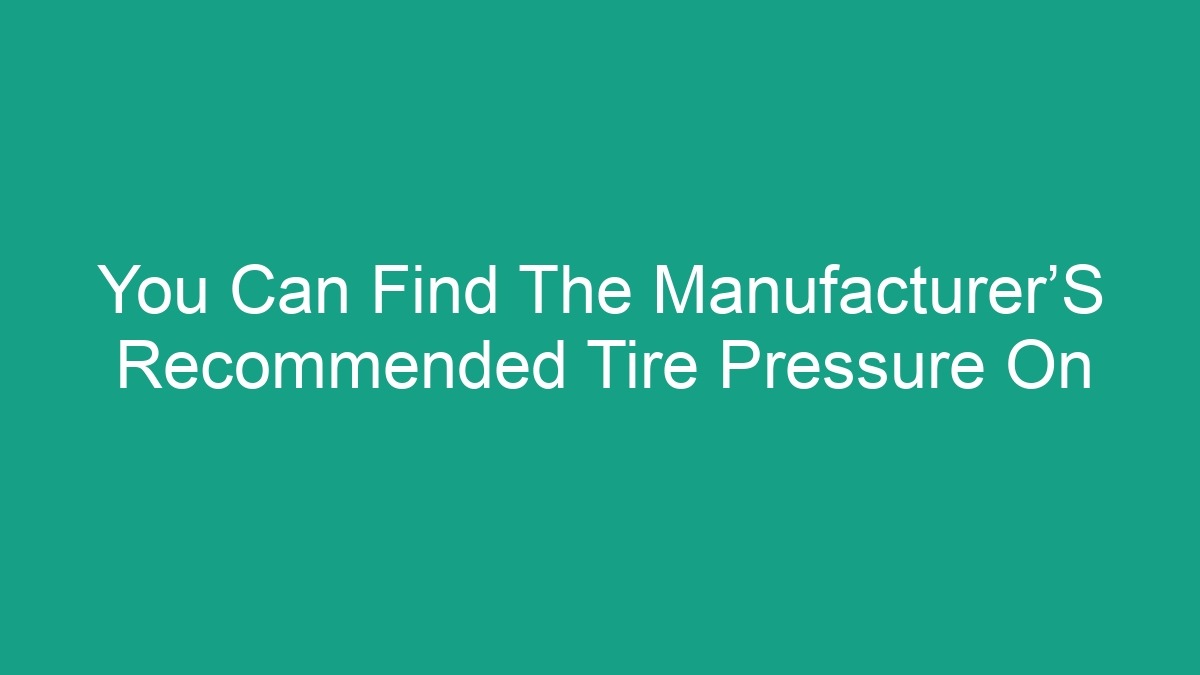
Introduction
When it comes to maintaining your vehicle, one of the most important aspects to consider is the tire pressure. It is crucial for the overall health and performance of your vehicle, as well as for your safety on the road. But how do you know the recommended tire pressure for your specific vehicle? In this article, we will explore where you can find the manufacturerʼs recommended tire pressure, why it is important to adhere to these recommendations, and how to properly maintain your tire pressure.
Where to Find the Manufacturerʼs Recommended Tire Pressure
The manufacturerʼs recommended tire pressure can typically be found in a few different places. It is important to note that the recommended tire pressure might differ depending on the make and model of your vehicle, so it is essential to consult the specific resources related to your vehicle.
Ownerʼs Manual: The most reliable source for the manufacturerʼs recommended tire pressure is your vehicleʼs ownerʼs manual. The manual will provide you with the specific tire pressure recommended by the manufacturer, typically measured in pounds per square inch (psi). This information is usually located in the maintenance section of the manual.
Door Jamb: Another common location to find the recommended tire pressure is on the driverʼs side door jamb. Often, there is a sticker on the door jamb that provides information about the recommended tire pressure for your vehicle. This is a quick and convenient reference point for checking your tire pressure.
Glove Box: Some vehicles may provide a tire information placard inside the glove box. This placard will contain the manufacturerʼs recommended tire pressure, as well as other important tire-related information.
Why it is Important to Adhere to the Recommended Tire Pressure
Adhering to the manufacturerʼs recommended tire pressure is crucial for several reasons. Not only does it ensure the safety of your vehicle, but it also affects the overall performance and longevity of your tires.
Tire Wear: Incorrect tire pressure can lead to uneven tire wear, reducing the lifespan of your tires. Underinflated tires cause the edges of the tread to wear out more quickly, while overinflated tires cause the center of the tread to wear out faster. This can result in the need for premature tire replacements.
Fuel Efficiency: Maintaining the recommended tire pressure can also improve fuel efficiency. Underinflated tires create more rolling resistance, which causes the vehicle to consume more fuel. By keeping your tires properly inflated, you can optimize your vehicleʼs fuel economy.
Handling and Safety: Properly inflated tires provide better handling and traction, especially in adverse weather conditions. This is crucial for vehicle safety, as it can help prevent accidents by ensuring your vehicle responds as intended in various driving scenarios.
How to Properly Maintain Your Tire Pressure
Now that you know where to find the manufacturerʼs recommended tire pressure and why it is important to adhere to these recommendations, it is essential to understand how to properly maintain your tire pressure.
Check Tire Pressure Regularly: It is recommended to check your tire pressure at least once a month, as well as before long road trips. This can be done using a tire pressure gauge, which is a simple tool available at most automotive supply stores.
Adjust Tire Pressure: If your tire pressure is below the recommended level, it is important to add air to the tires to reach the proper psi. Conversely, if the tire pressure is too high, you can release air using the valve stem and a tire pressure gauge. It is crucial to use a reliable pressure gauge to ensure accurate readings.
Consider External Factors: External factors such as extreme temperatures can affect tire pressure. During the winter, the cold temperature can cause tire pressure to drop, while the summer heat can increase tire pressure. Periodically checking your tire pressure during these temperature fluctuations is important for maintaining the recommended levels.
Conclusion
In conclusion, the manufacturerʼs recommended tire pressure plays a significant role in the overall performance, safety, and longevity of your vehicle. By knowing where to find this information and understanding the importance of adhering to these recommendations, you can take the necessary steps to properly maintain your tire pressure. Regularly checking and adjusting your tire pressure in accordance with the manufacturerʼs recommendations will not only ensure the safety of your vehicle but also contribute to its optimal performance and efficiency. Remember, the key to a smooth and safe ride starts with the right tire pressure.



